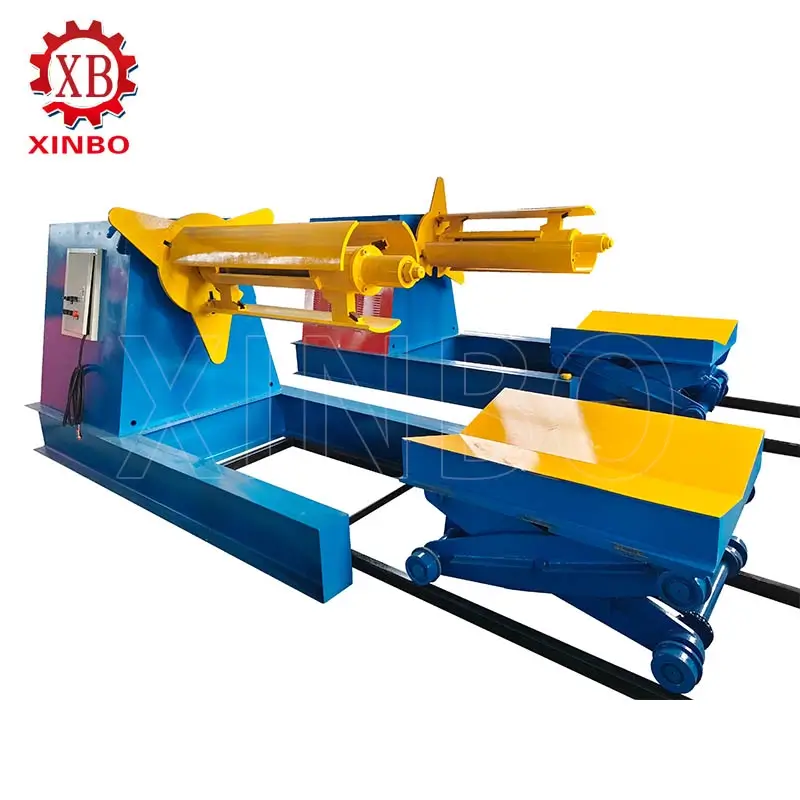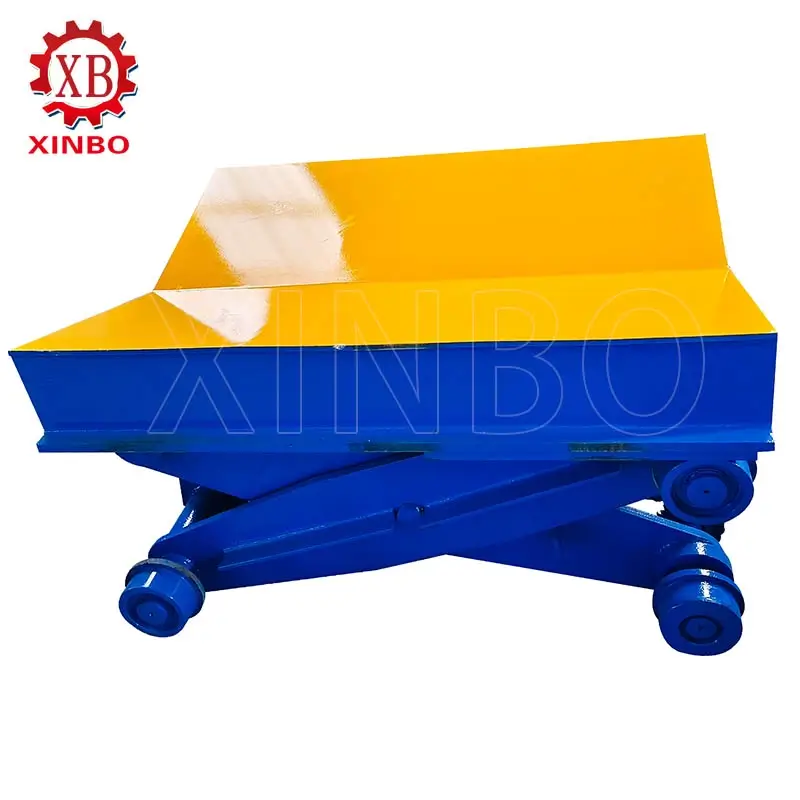Преимущества использования гидравлической машины Decoiler
Что такое гидравлический декоилер
А гидравлический декойлер машина Это особый инструмент. Он разворачивает большие металлические рулоны, такие как сталь, алюминий или медь. Эти рулоны превращаются в плоские листы для большей работы. Машина использует гидравлическую систему. Эта система контролирует раскрутку. Это гарантирует точность процесса. Кроме того, он предотвращает повреждение металла. Эти машины часто используются в таких местах, как строительство, производство автомобилей и формирование металла. В строительстве они очень важны. Они обрабатывают тяжелые рулоны. Эти рулоны позже становятся крышными листами, опорными балками или стенными покрытиями. Основными задачами гидравлических декойлеров являются развертывание больших, тяжелых металлических рулонов. Некоторые рулоны весят до 20 тонн. Они также постоянно подают металл в производственные линии.

Как работает гидравлический декоилер?
Гидравлический декойлер работает со многими деталями. Эти детали объединяются, чтобы развить металл плавно и тщательно:
- Разкачивающий Mandrel: Это главная часть. Он крепко держит рулон, когда он вращается. Движимые руки регулируются, чтобы соответствовать различным размерам роликов.
- Система гидравлического расширения: Гидравлическая мощность толкает мандрил, чтобы схватить внутренний край рулона. Это перестает скользять, пока машина работает.
- Система контроля напряжения: Это держит металлический лист стабильным, когда он разворачивается. Это обеспечивает хорошее качество. Он уменьшает изгибание или повреждение.
- Двигатель и трансмиссия: Двигатель приводит к вращению мандрила. Вы можете изменить скорость, чтобы соответствовать другим задачам, таким как формирование или резание.
- Система управленияУмные системы, такие как ПЛК или ЧПУ, дают точное управление. Они управляют скоростью, напряжением и сцеплением.
Гидравлическая система дает сильную мощность для тяжелых рулонов. Датчики гарантируют, что все работает правильно. Эта точность является ключом к строительству. Здесь важно качество материала.
Какие виды гидравлических декоилеров доступны?
Гидравлические декойлеры доступны в разных стилях. Каждый из них отвечает конкретным потребностям:
- Ручная гидравлическая DecoilersХорошо для небольших работ. Работники могут выполнять некоторые задачи вручную.
- Полуавтоматические гидравлические декоилеры: Эти смешивают автоматизацию с низкой стоимостью. Они экономят время, но остаются доступными.
- Полностью автоматические гидравлические декоилеры: Идеально подходит для больших производственных линий. Они беспрепятственно работают с машинами, такими как форматоры рулонов.
- Портативные гидравлические декоилерыСделано для использования на строительных площадках. Они легко перемещаются туда, где они нужны.
Эти типы работают во многих ситуациях. Они подходят как для гибких рабочих мест, так и для загруженного производства в мастерской.
Каковы ключевые части и особенности?
Гидравлические декойлеры имеют важные части:
- Разкачивающий Mandrel: Регулируется, чтобы соответствовать внутренним размерам рулона, как 460-520 мм. Он надежно держит рулоны.
- Система гидравлического расширенияДает давление до 20 МПа. Это крепко держит тяжелые рулоны.
- Системы двигателей и трансмиссий: Двигаются двигателями от 5,5 кВт до 7,5 кВт. Они имеют управление скоростью для плавной работы.
- Система управленияПростые в использовании экраны. Часто используйте ПЛК или ЧПУ для автоматической точности.
- Особенности безопасностиКнопки остановки, датчики и охранники обеспечивают безопасность работников.
Ключевыми особенностями для строительства являются прочные стальные рамы. Ультразвуковые системы управления скоростью плавно подают металл в формообразующие машины. Дополнительные детали, такие как катушки автомобилей, сокращаются по ручной работе.
Где используются гидравлические декоилеры в строительстве?
В строительных проектах гидравлические декойлеры являются обязательными инструментами. Они готовят сырье для многих видов применения:
- Производство стальной конструкции: Они разворачивают стальные рулоны для балок, колонн или других частей. Это обеспечивает точную подготовку к резке или пробиву.
- Производство крыши и покрытия стен: Алюминиевые или стальные листы сделаны быстро для крыши или стенных панелей. Они держат здания неприкосновенными к погоде.
- Большие настройки производства: Автоматические декойлеры обрабатывают много металлических листов. Они необходимы для стенных панелей или опор в мастерских.
- Подготовка на местеПортативные блоки позволяют рабочим развивать рулоны прямо на строительных площадках.
Специальные детали, такие как каналы HVAC или кабельные подносы, также нуждаются в этих машинах.
Каковы главные Гидравлические декойлеры Преимущества для строительства?
Гидравлические декойлеры приносят большие преимущества строительным проектам:
- Быстрая работаАвтоматизация сокращает потребности работников. Это ускоряет сроки реализации проекта. Большая производственная мощность подходит для больших рабочих мест.
- Лучшая точность: Стабильное развертывание дает идеальные размеры для крыши или конструктивных частей.
- Более безопасное использованиеВстроенные инструменты безопасности снижают риски. Это важно при обработке тяжелых рулонов на загруженных площадках.
- Работает со многими металлами: Они обрабатывают сталь, алюминий и медь. Они соответствуют различным размерам роликов.
- Со временем экономит деньгиСтартовая стоимость может быть высокой. Но меньше заработной платы работника и меньше растрачиваемого металла экономят деньги позже.
Эти машины улучшают рабочий процесс. Они способствуют успеху проекта.
Технические характеристики гидравлической машины Decoiler

Гидравлические декойлеры строятся с осторожностью. Они выполняют сложные строительные работы. Они имеют передовые детали для безопасной и быстрой работы. Ключевые спецификации включают регулируемые Mandrels. Эти подходят для внутренних размеров роликов от 380 до 600 мм. Это обеспечивает плотное сжатие. Система гидравлического расширения дает давление до 20 МПа. Это очень важно для больших, тяжелых роликов. Двигатели варьируются от 5,5 кВт до 7,5 кВт. Они имеют управление скоростью, чтобы соответствовать таким задачам, как формирование или резание.
Системы управления используют технологию ПЛК или ЧПУ. Они дают точные настройки напряжения и скорости. Простые экраны помогают работникам быстро корректировать вещи. Особенности безопасности включают кнопки остановки, датчики и охраны. Они защищают работников. Дополнительные детали, такие как катушки, облегчают загрузку и разгрузку. Они отрезали ручную работу.
Сильные стальные рамы сохраняются в грубых условиях. Ультразвуковый контроль скорости обеспечивает плавную подачу металла. Это ключ к изготовлению высококачественных крыш или конструктивных частей в строительстве.
Техническое обслуживание и эксплуатация
Хороший уход держит гидравлические декойлеры хорошо работают в течение многих лет. Часто проверяйте гидравлическую систему. Посмотрите на уровень жидкости. Проверьте линии и фитинги на утечки. Заменить гидравлическую жидкость при необходимости. Mandrels и части расширения требуют проверки износа или плохого выравнивания. Это позволяет делам проходить гладко. Смазать движущиеся части, такие как подшипники и цепи. Следуйте руководству производителя, чтобы избежать проблем.
Электрические детали требуют регулярных проверок. Посмотрите на панели управления, датчики и проводы. Убедитесь, что они работают правильно. Перед использованием машины проверьте функции безопасности. Проверьте кнопки остановки, датчики и охраны. Они должны работать.
Чтобы запустить машину, загрузите рулон с помощью катушки или крана. Поставьте рулон над мандрилем. Mandrel расширяется с помощью гидравлической силы. Это держит ролик жестко. Работники регулируют напряжение и скорость на системе управления. Они следят за развертыванием, чтобы обеспечить плавную подачу в машины, такие как форматоры рулонов или резки.
Обучение работников безопасному использованию. Это очень важно на загруженных строительных площадках с тяжелыми рулонами. Следование этим шагам ухода повышает работу машины. Это сокращает время простоя от сбоев.
Соображения по вопросам безопасности
Безопасность является главной проблемой при использовании гидравлических декойлеров. Тяжелые металлические рулоны могут быть рискованными. Хорошо обучайте работников. Они должны знать безопасные шаги и что делать в чрезвычайных ситуациях. Инструменты безопасности, такие как кнопки остановки, датчики и замки, помогают остановить аварии.
Работники должны носить оборудование безопасности. Это включает в себя очки, перчатки и сапоги со стальными пальцами. Это обязательно на строительных площадках. Поставьте машины на плоскую, стабильную землю. Это прекращает наклонение, особенно для портативных устройств в меняющихся рабочих местах.
Часто проверяйте охрану и другие защитные части. Они должны соответствовать таким правилам, как сертификация CE. Эти шаги значительно снижают риски. Они делают использование декойлеров безопаснее на загруженных строительных площадках.
Сколько стоит гидравлический декоилер?
Стоимость гидравлического декойлера зависит от типа и особенностей. Эксплуатационные расходы включают потребление энергии, замену гидравлической жидкости и регулярный уход. Стартовые затраты могут показаться большими по сравнению с ручными вариантами. Но долгосрочные сбережения делают это стоимым. Меньше заработной платы рабочих и меньше растраченной помощи металла. Энергосберегающие модели снижают затраты на электроэнергию. Они сохраняют хорошую производительность.
Обзор гидравлической машины XinBo Decoiler
СинбоПрофессиональная инженерная команда приносит новые технологии их машины. Они соответствуют стандартам евро, таким как сертификация CE. Эти машины используются во всем мире. Это включает Европу, Ближний Восток, Африку, Америку, Южную Америку и Азию.
СинбоДекойлеры имеют сильные стальные рамки. Они используют ультразвуковый контроль скорости. Они имеют дополнительную поддержку для тяжелых рулонов. Эти функции подходят для сложных работ, таких как изготовление панелей крыши. Фокус XinBo на качестве выходит за рамки производства. Они предлагают отличную послепродажную помощь. Это включает в себя руководство по установке.
Связанные посты

Хорошее качество
XinBo машина, делающая CO. LTD является профессиональным производителем и экспортером в машине для формирования рулона,
ПРОСМЕТЬ БОЛЬШЕ→

 Испанский
Испанский Россия
Россия





